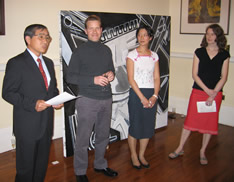 |
Counsellor Motai delivers a speech
(L-R: Jason Hayter, Wuon Gean Ho and Alexandra Blum) |
Distinguished Guests, Ladies and Gentlemen,
It is my great pleasure in welcoming you all to our latest exhibition this evening. Aside from welcoming you, I would like to inform you that I have, this week, just taken up the post of Director of the Japan Information and Cultural Centre at the Embassy of Japan. Therefore, I feel that it is quite fortunate for me to have the opportunity, so early on, to be able to meet and establish friendships with all of you who have strong links with Japan and the arts.
I am delighted to see that we have such an active JICC here in London. Not only is there a programme of Japanese films, but also numerous workshops for young British people to learn about Japan in Club Taishikan and, not least, a healthy programme of exhibitions here in the Embassy Foyer Gallery.
This time, the Embassy of Japan has acted as both catalyst and host to an exhibition of contemporary art by three wonderfully diverse British artists who have been, for varying lengths of time, immersed in Japanese culture as recipients of Japanese Government Scholarships: Ms Wuon Gean Ho , Mr Jason Hayter and Ms Alexandra Blum , from whom we shall all hear a little later and from whom we shall learn just how Japan, and the experience of their living there, has influenced their work.
Many of you may well already know that every year, approximately fifteen UK graduates will continue their studies in Japan for a minimum of eighteen months on Japanese Government (MEXT) Scholarships, administered by the Embassy of Japan here in London. The scholarship recipients are given the opportunity to research and develop in Japanese universities, furthering their academic and career objectives. A British graduate of any discipline can apply and applications from candidates who have no previous knowledge of the Japanese language or Japan are welcomed. There are all sorts of scholars in Japan at the moment: we have astrophysicists, biologists, comparative lawyers, and dentists. I am sure it won't be long before we get all the way through the alphabet to xylophonists, yacht scientists and zoologists! It is, in fact, rather rare to send artists and architects to study in Japan, and we are extremely lucky to be able to show the work of three of them here at the Embassy.
I have also learned, since I arrived, that on returning to the United Kingdom, scholars are eligible to join their very own alumni association: BAMS ? the British Association of Monkasho Scholars. BAMS is a valuable forum in which the ties that link our two countries are nurtured. Through the bonds of their joint experiences in Japan and the work that they do back here, I very much appreciate the former scholars' contribution to UK-Japan relations. I hope that they, in turn, are able to encourage more young people to take up the challenge and study in Japan.
It is my hope, that through such programmes of cultural exchange, new friendships between Japanese and British people will continue to be inspired. It is not only what is learned within the confines of the classroom, but also that which is gleaned outside which are important to the further development and enrichment of our mutual understanding and bi-lateral ties.
Related link:
Featured Events: triple take
|


